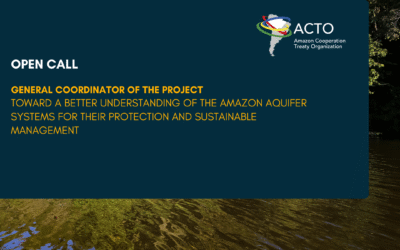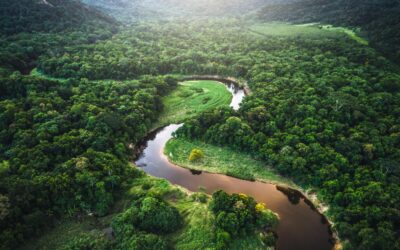Ambassador, how do the Member Countries of ACTO define the water resources of the Amazon Basin, the largest basin in the world?
Water resources are considered by the Member Countries of ACTO as strategic and priority resources not only for the life of natural ecosystems but for the Sustainable Development and Quality of Life of local and national populations in each of the ACTO Member Countries, whose conservation and sustainable management is under the full sovereignty of each country.
However, due to the transboundary nature of the Amazon Basin´s water resources, regional and international cooperation is required for the implementation of joint actions for the conservation and integrated management of these resources, and therefore this is an important issue of the ACTO’s Amazonian Strategic Cooperation Agenda adopted by the Ministers of Foreign Affairs of the Member Countries of the Organization, in 2010.
An effort that has brought together the Member Countries of ACTO has been the joint work performed through the GEF Amazon Project – Water Resources and Climate Change. What is the balance of this regional initiative after 4 years of work in the Amazon Basin?
The balance is very positive, since it has enabled, among other things: i) the enrichment and deepening of knowledge on the subject of Amazonian transboundary water resources through the analysis and joint identification of the main problems affecting their conservation and integrated management, which has positively resulted in the formulation of a shared regional vision for conservation, management, and sustainable use of the resources; ii) the strengthening of national capacities through training and capacity building actions of technical staff of the national institutions responsible for water resources in each country; iii) the implementation of pilot projects aimed to support monitoring of water resources with emphasis on the establishment and improvement of technological platforms for the collection and data processing in the countries, early warning systems, hydro-meteorological stations, vulnerability maps: the Hydro-Climatic Vulnerability Atlas and the strengthening of regional networks of technical and scientific exchange among the most important results.
Could you explain to us, which are the main verifiable results of the GEF Amazon Project considering the Sustainable Development Goals?
In addition to deepening knowledge regarding the Amazon Basin´s transboundary water resources and the development of a regional strategy for the Integrated Management of Water Resources in the Amazon basin, within the context of the GEF Amazon Project, it can be tangibly identified the improvement of tools and technologies for the permanent monitoring of water resources, especially those technological platforms mentioned and listed in the previous question as well as the training and capacity building programs in the framework of South-South Cooperation of ANA (Agência Nacional de Aguas for its acronym in Portuguese) Brazil.
Moreover, the Project strengthened the adaptation capacity and response of local governments to extreme climate events through: i) the implementation of risk management models, ii) tri-national early warning system in border areas, iii) relocation policies of vulnerable populations, iv) productive alternatives in flooded areas, benefiting a total of 475 thousand people.
There is no doubt that these achievements will support the implementation, both at the regional and local levels, of several Sustainable Development Goals of the United Nations 2030 Agenda, especially the Goals: 3, 6, 11, 13, 15 and 17.
How have the Governments reacted to the Strategic Action Program (SAP) for the Amazon Basin, which is the main agreement reached by the GEF Amazon Project?
There is a very high expectation, since the SAP reflects the consented regional vision on the priority issues for the conservation and the Integrated Management of the Amazonian transboundary water resources and the joint strategic actions to undertake at the regional level to solve the problems and/or mitigate their negative effects.
In addition, the countries consider that the implementation of the SAP would allow the articulation of national and regional initiatives. In other words, it is a complementary mechanism to the national policies related to water resources, allowing to direct part of countries´ GEF STAR resources for the implementation of Amazonian projects in this matter as well as to identify national counterpart resources, considering and adding to the contribution of the cooperation of the GEF Amazon Project, other initiatives on water resources executed with national and international cooperation funds in each country.
Which actions will ACTO carry out to identify the required funding for the Strategic Action Program in the Amazon Basin?
The ACTO, through its Permanent Secretariat (PS/ACTO), will continue supporting the countries in the process of identification and allocation of international cooperation funds, including GEF resources, to projects on transboundary water resources, as well as the national counterparts. The PS/ACTO will also support the Member Countries in the process of formulation and presentation of projects, within the framework of the strategic actions of the SAP, to other agencies and sources of international cooperation, as well as to the national authorities in each country responsible for funding projects in the Amazon region.
Given that the ACTO aims to increase scientific research and exchange of information among the countries, we are interested in knowing how this purpose is fulfilled in the tasks undertaken within the GEF Amazon Project, particularly in which demonstrable activities?
This issue was partially covered in questions number 2 and 3, but we could highlight specially, the facilitating role of the training and capacity building activities and the exchange of experience and information on water resources developed under the GEF Amazon Project: especially, the initiatives being implemented through the ANA Brazil, for the establishment and strengthening of regional networks for the exchange of technical and scientific experts from the ACTO Member Countries.
A demonstrable and remarkable example in the area of research and exchange of scientific and technical experiences is the pilot project being jointly implemented by the most important Amazonian research institutes in the region: the IIAP of Peru, the SINCHI of Colombia and the INPA Brazil, for the development of a regional information platform in the framework of the Integrated Information System, connecting Biodiversity databases.
What message would you like to convey to the national authorities responsible for water resources in the different countries?
To continue to deepen the Amazonian regional cooperation for the conservation and integrated management of water resources as a medium and long-term strategy for the sustainable development of the ACTO Member Countries, and for the improvement of life quality of the Amazonian populations.











